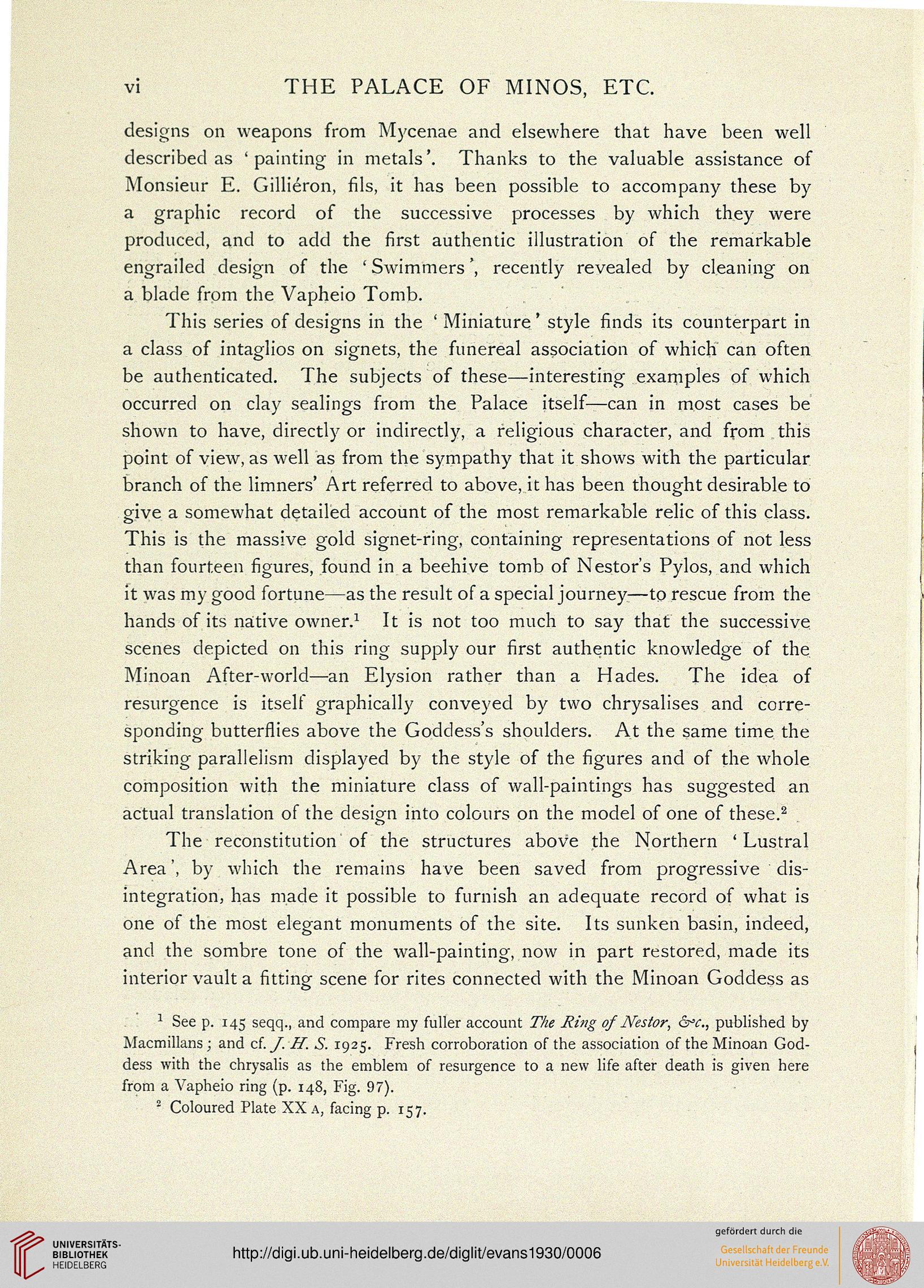vi THE PALACE OF MINOS, ETC.
designs on weapons from Mycenae and elsewhere that have been well
described as ' painting in metals'. Thanks to the valuable assistance of
Monsieur E. Gillieron, fils, it has been possible to accompany these by
a graphic record of the successive processes by which they were
produced, and to add the first authentic illustration of the remarkable
engrailed design of the ' Swimmers', recently revealed by cleaning on
a blade from the Vapheio Tomb.
This series of designs in the ' Miniature' style finds its counterpart in
a class of intaglios on signets, the funereal association of which can often
be authenticated. The subjects of these—interesting examples of which
occurred on clay sealings from the Palace itself—can in most cases be
shown to have, directly or indirectly, a religious character, and from, this
point of view', as well as from the sympathy that it shows with the particular
branch of the limners' Art referred to above, it has been thought desirable to
give a somewhat detailed account of the most remarkable relic of this class.
This is the massive gold signet-ring, containing representations of not less
than fourteen figures, found in a beehive tomb of Nestor's Pylos, and which
ft was my good fortune—as the result of a special journey;—to rescue from the
hands of its native owner.1 It is not too much to say that the successive
scenes depicted on this ring supply our first authentic knowledge of the
Minoan After-world—an Elysion rather than a Hades. The idea of
resurgence is itself graphically conveyed by two chrysalises and corre-
sponding butterflies above the Goddess's shoulders. At the same time the
striking parallelism displayed by the style of the figures and of the whole
composition with the miniature class of wall-paintings has suggested an
actual translation of the design into colours on the model of one of these.2
The reconstitution'of the structures above the Northern ' Lustral
Area', by which the remains have been saved from progressive dis-
integration, has made it possible to furnish an adequate record of what is
one of the most elegant monuments of the site. Its sunken basin, indeed,
and the sombre tone of the wall-painting, now in part restored, made its
interior vault a fitting scene for rites connected with the Minoan Goddess as
1 See p. 145 seqq., and compare my fuller account The Ring of Nestor, &°c, published by
Macmillans; and cl.J.H. S. 1925. Fresh corroboration of the association of the Minoan God-
dess with the chrysalis as the emblem of resurgence to a new life after death is given here
from a Vapheio ring (p. 148, Fig. 97).
2 Coloured Plate XX a, facing p. T57.
designs on weapons from Mycenae and elsewhere that have been well
described as ' painting in metals'. Thanks to the valuable assistance of
Monsieur E. Gillieron, fils, it has been possible to accompany these by
a graphic record of the successive processes by which they were
produced, and to add the first authentic illustration of the remarkable
engrailed design of the ' Swimmers', recently revealed by cleaning on
a blade from the Vapheio Tomb.
This series of designs in the ' Miniature' style finds its counterpart in
a class of intaglios on signets, the funereal association of which can often
be authenticated. The subjects of these—interesting examples of which
occurred on clay sealings from the Palace itself—can in most cases be
shown to have, directly or indirectly, a religious character, and from, this
point of view', as well as from the sympathy that it shows with the particular
branch of the limners' Art referred to above, it has been thought desirable to
give a somewhat detailed account of the most remarkable relic of this class.
This is the massive gold signet-ring, containing representations of not less
than fourteen figures, found in a beehive tomb of Nestor's Pylos, and which
ft was my good fortune—as the result of a special journey;—to rescue from the
hands of its native owner.1 It is not too much to say that the successive
scenes depicted on this ring supply our first authentic knowledge of the
Minoan After-world—an Elysion rather than a Hades. The idea of
resurgence is itself graphically conveyed by two chrysalises and corre-
sponding butterflies above the Goddess's shoulders. At the same time the
striking parallelism displayed by the style of the figures and of the whole
composition with the miniature class of wall-paintings has suggested an
actual translation of the design into colours on the model of one of these.2
The reconstitution'of the structures above the Northern ' Lustral
Area', by which the remains have been saved from progressive dis-
integration, has made it possible to furnish an adequate record of what is
one of the most elegant monuments of the site. Its sunken basin, indeed,
and the sombre tone of the wall-painting, now in part restored, made its
interior vault a fitting scene for rites connected with the Minoan Goddess as
1 See p. 145 seqq., and compare my fuller account The Ring of Nestor, &°c, published by
Macmillans; and cl.J.H. S. 1925. Fresh corroboration of the association of the Minoan God-
dess with the chrysalis as the emblem of resurgence to a new life after death is given here
from a Vapheio ring (p. 148, Fig. 97).
2 Coloured Plate XX a, facing p. T57.





